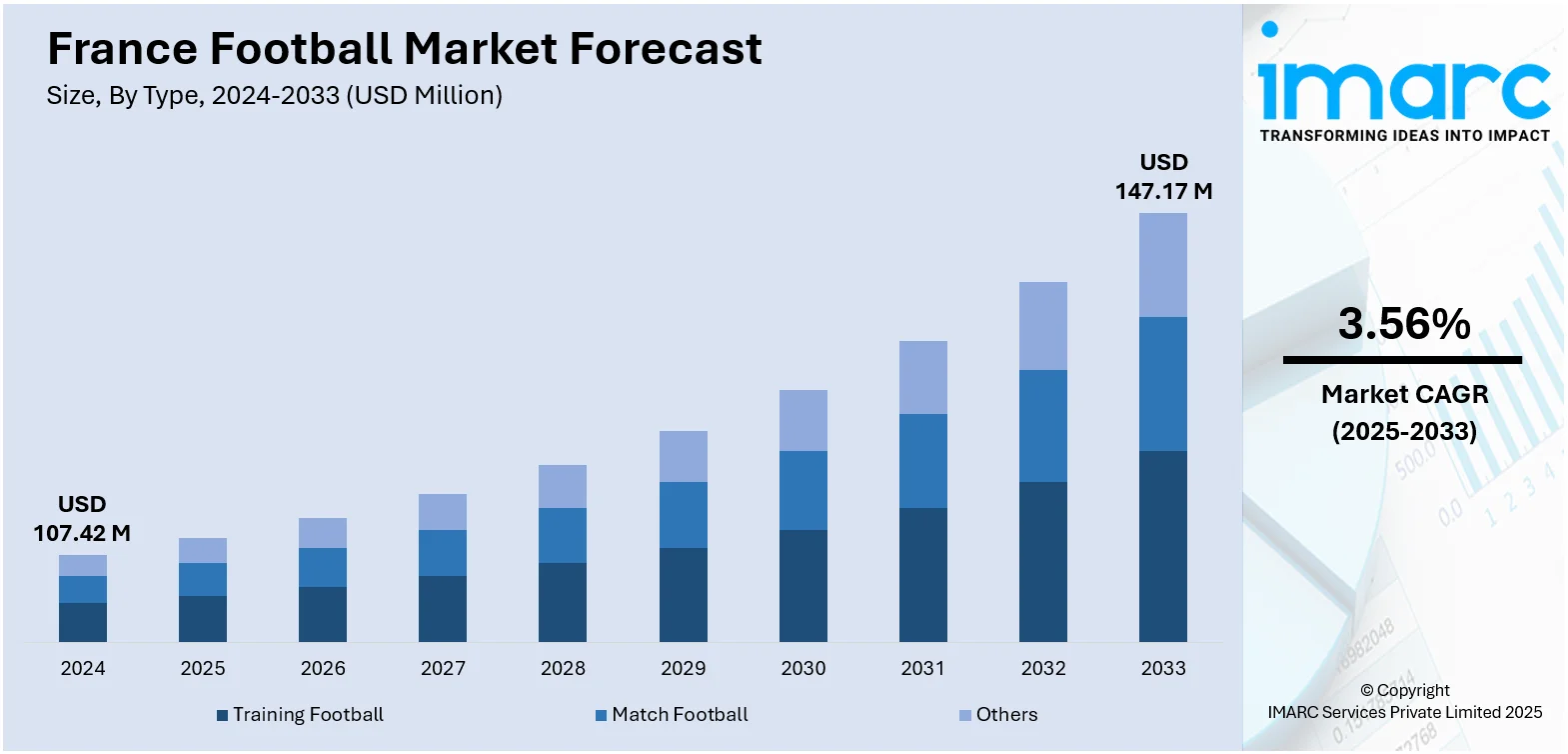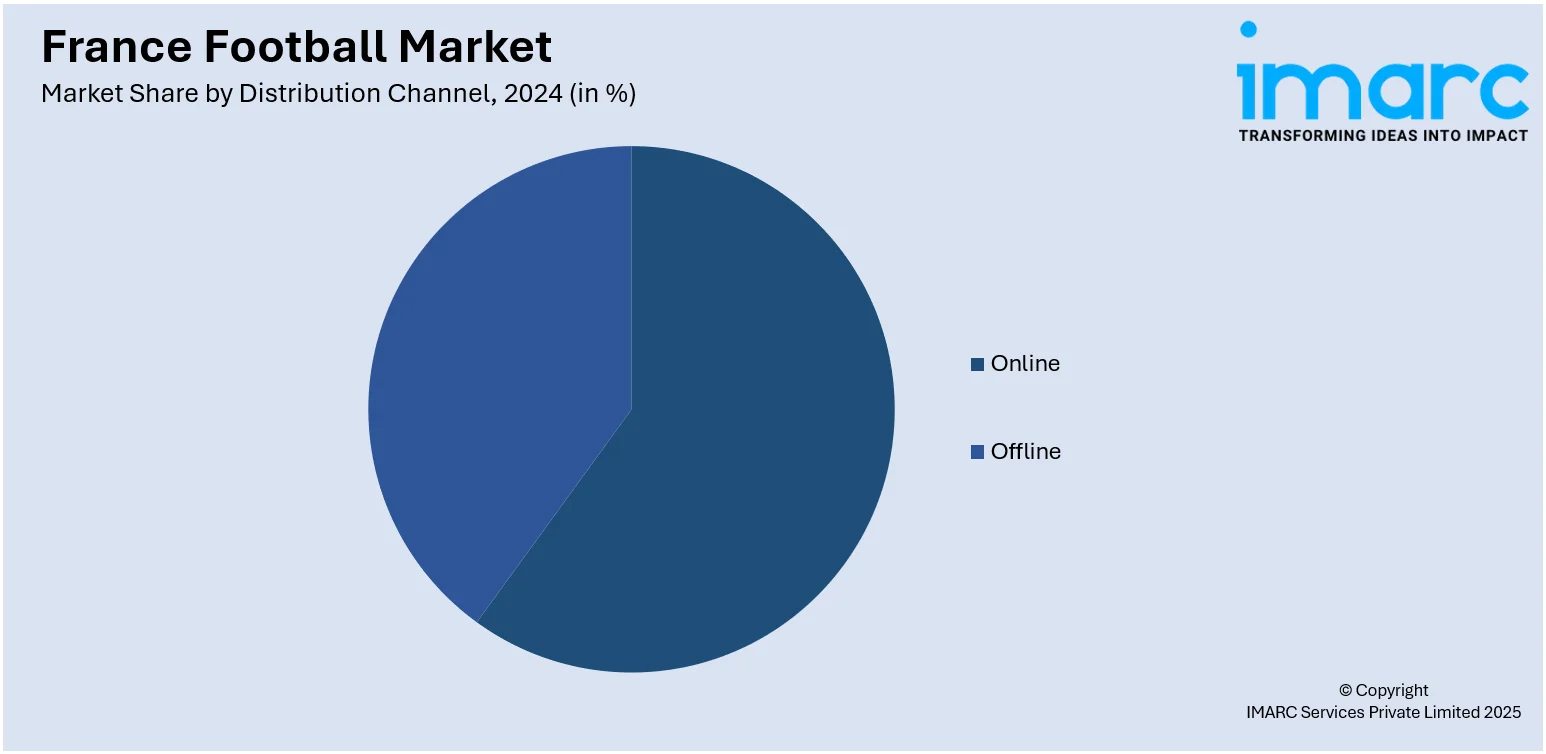
France Football Market Size, Share, Trends and Forecast by Type, Size, Distribution Channel, and Region, 2025-2033
France Football Market Overview:
The France football market size reached USD 107.42 Million in 2024. Looking forward, IMARC Group expects the market to reach USD 147.17 Million by 2033, exhibiting a growth rate (CAGR) of 3.56% during 2025-2033. The expansion of women’s football and Financial Fair Play regulations are driving the football market in France. Women’s football benefits from increased funding, media exposure, and rising participation, while FFP ensures financial stability, attracting investors and ensuring long-term market sustainability, thereby contributing to the expansion of the France football market share.
|
Report Attribute
|
Key Statistics
|
|---|---|
|
Base Year
|
2024 |
|
Forecast Years
|
2025-2033
|
|
Historical Years
|
2019-2024
|
| Market Size in 2024 | USD 107.42 Million |
| Market Forecast in 2033 | USD 147.17 Million |
| Market Growth Rate 2025-2033 | 3.56% |
France Football Market Trends:
Expansion of Women’s Football
The rising importance of women’s football in France is supporting the market growth, with the industry witnessing swift expansion in recent years. This growth is driven by increased funding in the women’s sport, enhanced media exposure, and a notable rise in match participation. French teams, including Olympique Lyonnais, have been at the forefront of European tournaments, enhancing the league's reputation and drawing elite talent. The increase in visibility is also supported by the success of the French women’s national team in international competitions, such as the Women’s World Cup, which is further enhancing the popularity of the sport. With the growing interest in women’s football, new sources of income are developing, ranging from enhanced sponsorship agreements to the growth in merchandise sales. A significant development is the announcement in 2025 by the LFFP regarding plans for a new women's League Cup. This contest is intended to assist clubs facing financial difficulties and seeks to produce income via a naming sponsor. These initiatives contribute to larger efforts aimed at stabilizing and growing the women’s professional football landscape in France. With an increasing number of young girls participating in the sport, the prominence of women’s teams is on the rise, drawing in a broader and more involved fan base.

To get more information on this market, Request Sample
Financial Fair Play and Economic Stability
Financial Fair Play (FFP) rules are greatly influenced the French football market growth by encouraging financial stability and prudent expenditure among teams. By making sure clubs stay within their financial limits, FFP is decreasing dependence on outside funding and uncontrolled transfer expenses, demanding clubs to maintain balanced financial statements. This motivates clubs to create lasting income via strategic investments, like player development and commercial alliances. As a result, FFP has shielded the league from financial turmoil, fostering a more appealing setting for investors, sponsors, and broadcasters. By following these guidelines, clubs uphold competitive integrity and ensure long-term sustainability, which aids in the overall stability of the market. In 2025, FFF president Philippe Diallo unveiled intentions to reform French football by substituting the LFP with a club-owned organization, modeled after the Premier League. This new firm, supported by stakeholders such as clubs, CVC Capital, and the FFF, would handle the management and promotion of competitions. The reform aims to enhance transparency, efficiency, and financial stability in French football, solidifying the concepts of financial sustainability and promoting a more reliable, stable market. This change signifies a dedication to sustainable growth while lowering vulnerability to financial risks, guaranteeing that French football stays competitive internationally while maintaining financial stability.
France Football Market Segmentation:
IMARC Group provides an analysis of the key trends in each segment of the market, along with forecasts at the country and regional levels for 2025-2033. Our report has categorized the market based on type, size, and distribution channel.
Type Insights:
- Training Football
- Match Football
- Others
The report has provided a detailed breakup and analysis of the market based on the type. This includes training football, match football, and others.
Size Insights:
- Size 1
- Size 2
- Size 3
- Size 4
- Size 5
A detailed breakup and analysis of the market based on the size have also been provided in the report. This includes size 1, size 2, size 3, size 4, and size 5.
Distribution Channel Insights:

- Online
- Offline
The report has provided a detailed breakup and analysis of the market based on the distribution channel. This includes online and offline.
Regional Insights:
- Paris Region
- Auvergne-Rhône-Alpes
- Nouvelle-Aquitaine
- Hauts-de-France
- Occitanie
- Provence Alpes Côte d’Azur
- Grand Est
- Others
The report has also provided a comprehensive analysis of all the major regional markets, which include Paris Region, Auvergne-Rhône-Alpes, Nouvelle-Aquitaine, Hauts-de-France, Occitanie, Provence Alpes Côte d’Azur, Grand Est, and others.
Competitive Landscape:
The market research report has also provided a comprehensive analysis of the competitive landscape. Competitive analysis such as market structure, key player positioning, top winning strategies, competitive dashboard, and company evaluation quadrant has been covered in the report. Also, detailed profiles of all major companies have been provided.
France Football Market News:
- In May 2025, OL LYONNES renewed its partnership with Crédit Agricole Centre-Est for three more seasons, supported by SPORTFIVE. The collaboration aims to boost the visibility, inclusion, and appeal of women’s football. The Crédit Agricole logo will feature on the team's jerseys as part of this strengthened commitment.
- In May 2025, Arkema announced a three-year extension of its naming partnership with the Arkema Première Ligue, continuing through the 2027/2028 season. The renewal reinforces Arkema’s commitment to advancing women’s football in France and globally. It supports both elite and amateur clubs and aligns with values of inclusion, innovation, and social transformation.
France Football Market Report Coverage:
| Report Features | Details |
|---|---|
| Base Year of the Analysis | 2024 |
| Historical Period | 2019-2024 |
| Forecast Period | 2025-2033 |
| Units | Million USD |
| Scope of the Report |
Exploration of Historical Trends and Market Outlook, Industry Catalysts and Challenges, Segment-Wise Historical and Future Market Assessment:
|
| Types Covered | Training Football, Match Football, Others |
| Sizes Covered | Size 1, Size 2, Size 3, Size 4, Size 5 |
| Distribution Channels Covered | Online, Offline |
| Regions Covered | Paris Region, Auvergne-Rhône-Alpes, Nouvelle-Aquitaine, Hauts-de-France, Occitanie, Provence Alpes Côte d’Azur, Grand Est, Others |
| Customization Scope | 10% Free Customization |
| Post-Sale Analyst Support | 10-12 Weeks |
| Delivery Format | PDF and Excel through Email (We can also provide the editable version of the report in PPT/Word format on special request) |
Key Questions Answered in This Report:
- How has the France football market performed so far and how will it perform in the coming years?
- What is the breakup of the France football market on the basis of type?
- What is the breakup of the France football market on the basis of size?
- What is the breakup of the France football market on the basis of distribution channel?
- What is the breakup of the France football market on the basis of region?
- What are the various stages in the value chain of the France football market?
- What are the key driving factors and challenges in the France football market?
- What is the structure of the France football market and who are the key players?
- What is the degree of competition in the France football market?
Key Benefits for Stakeholders:
- IMARC’s industry report offers a comprehensive quantitative analysis of various market segments, historical and current market trends, market forecasts, and dynamics of the France football market from 2019-2033.
- The research report provides the latest information on the market drivers, challenges, and opportunities in the France football market.
- Porter's five forces analysis assist stakeholders in assessing the impact of new entrants, competitive rivalry, supplier power, buyer power, and the threat of substitution. It helps stakeholders to analyze the level of competition within the France football industry and its attractiveness.
- Competitive landscape allows stakeholders to understand their competitive environment and provides an insight into the current positions of key players in the market.
Need more help?
- Speak to our experienced analysts for insights on the current market scenarios.
- Include additional segments and countries to customize the report as per your requirement.
- Gain an unparalleled competitive advantage in your domain by understanding how to utilize the report and positively impacting your operations and revenue.
- For further assistance, please connect with our analysts.
 Request Customization
Request Customization
 Speak to an Analyst
Speak to an Analyst
 Request Brochure
Request Brochure
 Inquire Before Buying
Inquire Before Buying




.webp)




.webp)












